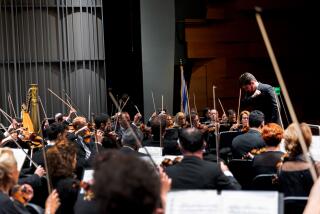Shankar’s Daughter Revives Sitar Work
- Share via
LA JOLLA — “If East has to meet West,” a music critic wrote of the 1971 premiere of Ravi Shankar’s First Sitar Concerto in London, “then few musicians have achieved it with such open joy as Ravi Shankar.” Dated, provincial words, perhaps. If music, if culture, if life have taught us anything in the past few decades, it is that East most definitely must, and does, meet West. Indeed, open, joyous multicultural encounters have been the tradition in California music for close to a century.
Still, Shankar’s contribution to a one-world music is a towering one, be it his collaborations with violinist Yehudi Menuhin or his profound influence on classical music (Philip Glass), pop (the Beatles), blues (Paul Butterfield) and jazz (John Coltrane). His legacy seems to grow every day, but somehow neglected have been his two marvelous sitar concertos, the first written for the London Symphony Orchestra and Andre Previn; the second, in 1981, for the New York Philharmonic with Zubin Mehta.
One reason for the neglect, of course, is that the concertos were written for Shankar as soloist, and the 78-year-old sitarist, though still performing, isn’t as active as he was. But that problem is now solved for the first concerto. Anoushka Shankar, the composer’s daughter and a quickly rising sitar star at age 17, performed it with the La Jolla Symphony on Saturday night.
The circumstances were not ideal. The cavernous, institutional Mandeville Auditorium at UC San Diego is an off-putting concert space, although the acoustics are surprisingly acceptable. The La Jolla Symphony is mostly amateur and sounds it.
But there were compensations. The orchestra has a new music director this year, Harvey Sollberger, who is best known as a flutist with sensational technique but who is also a sure conductor. It fills an important need in the community, willing to undertake interesting challenges, unlike the newly re-constituted, mainstream-bound San Diego Symphony. It is the Shankars’ hometown band; they live in Escondido and Ravi is regents professor at UCSD. And, on an occasion like this, it can draw a full house, an eager mixed audience of young and old, exactly the crowds the Los Angeles Philharmonic has so much trouble drawing.
Shankar’s concerto is a compelling, almost textbook-ideal adaptation of one musical tradition into another. Its melodies and rhythms come from raga, and the techniques of development also rely on Indian tradition, including sections for improvisation by the soloist. But Shankar uses the Western orchestra with imagination. Sometimes he looks for equivalents: Bongos serve as tabla; two harps play scales, echoing the sitar; the strings fill in the tambura’s drone. Sometimes he creates new effects, as in a stunning lyrical horn solo or the wonderful wind and percussion writing. The blend of sitar (lightly amplified) and the orchestra sounds effortless.
Though not yet quite the dazzling improviser that her father became, Anoushka is a serene performer with an exciting technique. She is maybe being too quickly pushed into fame with an overeager campaign for her new EMI recording contract. But if this performance was meant as a tryout for the concerto before moving on to more accomplished ensembles, she is ready to light up any traditional orchestra’s season.
Sollberger began with Mussorgsky’s “Night on Bald Mountain” and, ambitiously, Stravinsky’s “Rite of Spring.” Fascinating connections were made: Stravinsky and Shankar both place a primacy of melody and rhythm over harmony but from radically different traditions. The music was an obstacle course for the stumbling orchestra but hardly a problem for the appreciative audience. Quick, fly these folks up to fill the empty Philharmonic seats at the Dorothy Chandler Pavilion.
More to Read
The biggest entertainment stories
Get our big stories about Hollywood, film, television, music, arts, culture and more right in your inbox as soon as they publish.
You may occasionally receive promotional content from the Los Angeles Times.










